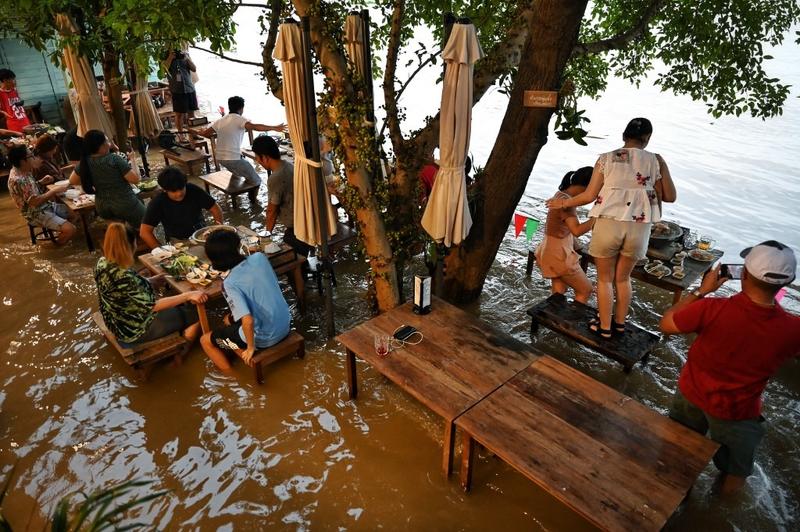 This photo taken on Oct 7, 2021, shows people standing up whilst enjoying dinner at the Chaopraya Antique Cafe, as flood water from the Chao Phraya River surges into the restaurant, in Nonthaburi province north of Bangkok. (LILLIAN SUWANRUMPHA / AFP)
This photo taken on Oct 7, 2021, shows people standing up whilst enjoying dinner at the Chaopraya Antique Cafe, as flood water from the Chao Phraya River surges into the restaurant, in Nonthaburi province north of Bangkok. (LILLIAN SUWANRUMPHA / AFP)
Southeast Asian countries face severe challenges to significantly reduce emissions and help limit global warming to well below 2 degrees Celsius, analysts say.
These commitments are now in focus as the world prepares for the 26th UN Climate Change Conference of the Parties (COP26), which will be held from Oct 31 to Nov 12 in Glasgow, Scotland, in the United Kingdom.
Climate action from Southeast Asia is being closely monitored as the region remains dependent on coal as an energy source — a key contributor to the rise in emissions.
According to the latest Climate Action Tracker published in September, climate action by Indonesia and Vietnam is rated “highly insufficient”, while that of Singapore and Thailand are “critically insufficient”.
The CAT is prepared by Germany-based independent research groups, Climate Analytics and New Climate Institute.
Renato Redentor Constantino, executive director at the Manila-based Institute for Climate and Sustainable Cities, said that while Southeast Asian governments have made “decent climate targets and decent real economy directions”, he thinks there is “absurd pressure” for the region to decarbonize in the same timeline as developed countries.
“In the face of climate impacts coming our way, it is wrong to expect Southeast Asia to take on targets similar to what Germany, United States, Japan and Australia are expected to do. This is because we end up making up for the failures of Europe, North America, and Australia,” he said.
Indonesia’s latest emission target, submitted to the UN in July, is unchanged from 2016: it commits to reduce emissions by 29 percent under a business-as-usual scenario, and by 41 percent (with international support) by 2030.
“The continued reliance on fossil fuels and deforestation remain two of the key climate concerns in Indonesia,” said Jamie Wong, New Climate’s climate policy analyst for Indonesia.
Coal accounts for roughly 60 percent of electricity generation in Indonesia. While the state-owned utility Perusahaan Listrik Negara said that it will stop building coal-fired power plants after 2023, experts believe this is not enough to drastically reduce emissions.
A joint report by Climate Analytics and New Climate Institute said Indonesia’s palm oil industry is “in large part responsible” for the country’s deforestation and for peat land draining, leading to higher occurrence of peat fires.
Indonesia lost an average of close to 500,000 hectares of primary forest each year between 2000 to 2015.
Arief Wijaya, senior manager for climate, forests, and the ocean at the Indonesian branch of WRI, said the nation “can have more space to increase their climate ambitions”.
Thailand’s 2030 target is likewise unchanged: it commits to reduce emissions by 20 percent under a business-as-usual scenario, and by 25 percent (with international support).
Climate Analytics and New Climate Institute said in their report that while Thailand is planning to reduce dependence on coal, it also plans to ramp up the use of gas. They said gas, which is termed as a “bridging fuel”, is also a fossil fuel “and still needs to be phased out as soon as possible”.
“Thailand’s climate action historically cannot be considered ambitious,” said Swithin Lui, New Climate’s climate policy analyst for Thailand. But he noted that the pandemic has been hard on the country and most of the efforts are now directed toward economic recovery.
Lui remains hopeful for Thailand, citing the National Energy Plan which aims to generate 50 percent of its electricity from renewables by 2065. He added that Thailand’s plan to become the electric vehicle hub of Southeast Asia will also help in cutting emissions.
Under its National Electric Vehicle Policy, Thailand aims to produce more than 700,000 electric vehicles, accounting for at least 30 percent of total domestic vehicle production by 2030. It also aims to export EVs from 2035.
Malaysia has increased its 2030 target. In 2016, it pledged to reduce emissions by 35 percent under a business-as-usual scenario. This year, that target was raised to 45 percent.
Finance Minister Tengku Zafrul Tengku Abdul Aziz said in an Oct 15 virtual briefing that the country will focus on green investments to reduce emissions, according to a report filed by state news agency Bernama.
Malaysia aims to reduce reliance on coal-powered plants and retain at least 50 percent forest cover, Tengku Zafrul said.


